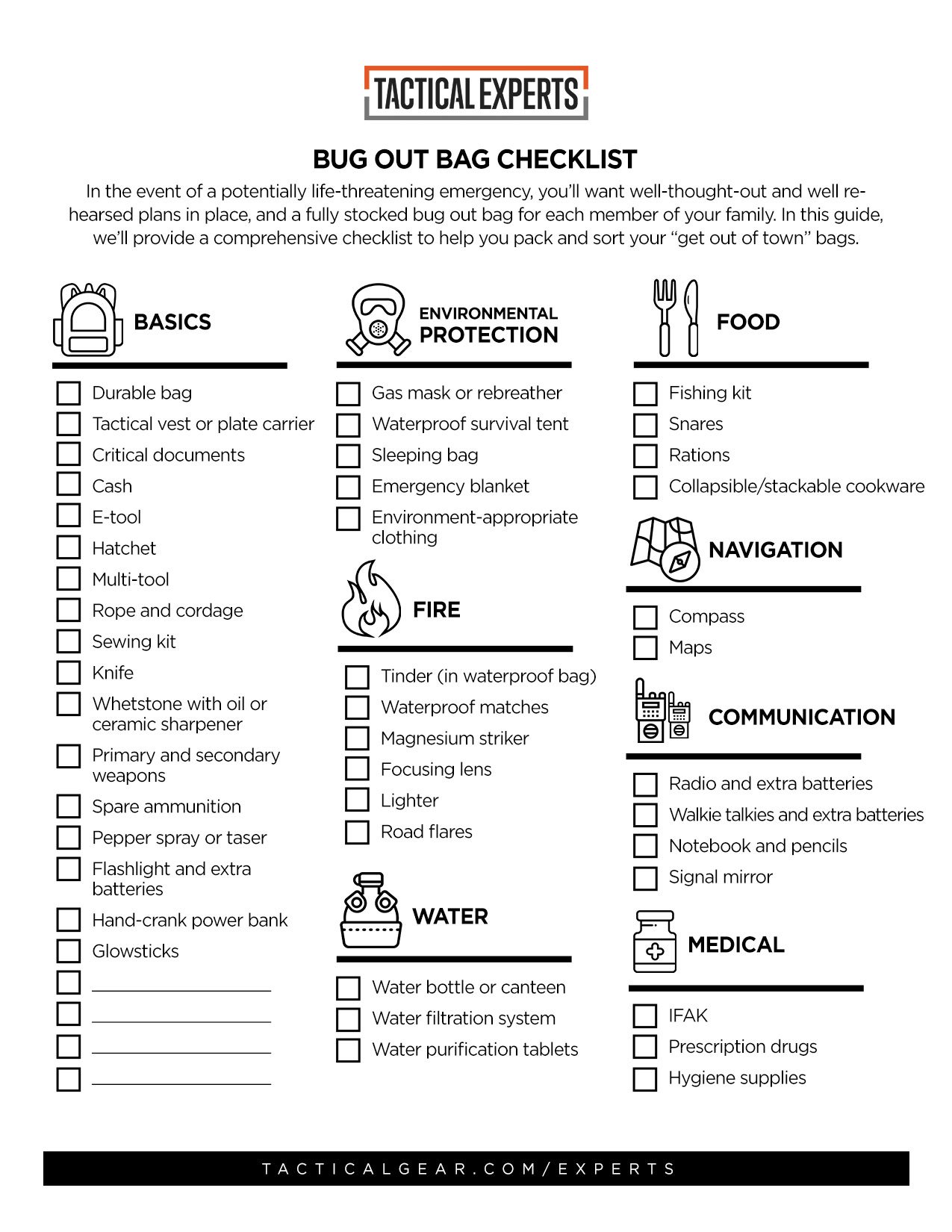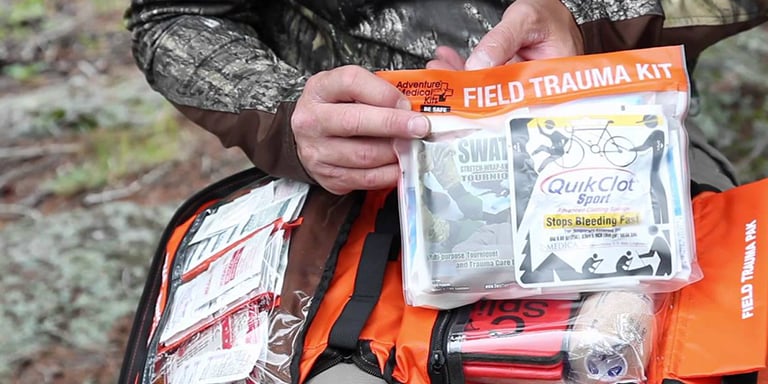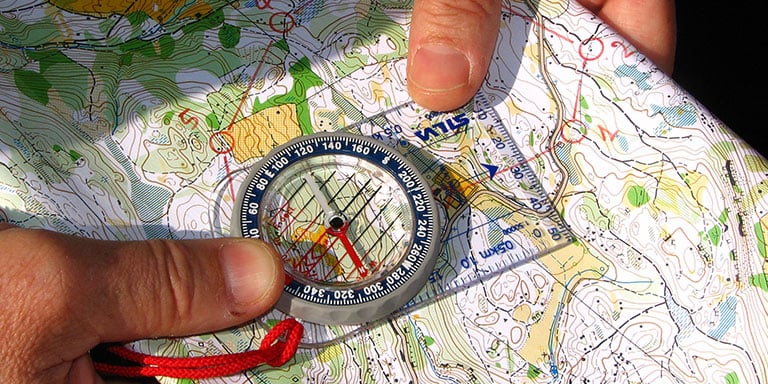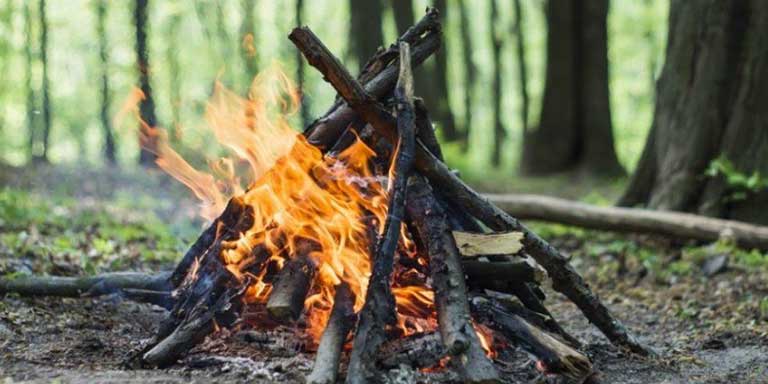
Share:
Bug Out Bag Checklist: The Essential Guide to Bugging Out
In the event of a potentially life-threatening emergency, you'll want well-thought-out and well-rehearsed plans in place, and a fully-stocked bug out bag for each member of your family. In this guide, we'll provide a comprehensive checklist to help you pack and sort your "get out of town" bags.
Note that we aren't necessarily suggesting that you try to cram every item on this list into a single bag. The contents of your ideal bug out bag will vary according to your environment, how much weight you can carry, how many other people you expect to have in your party and several other factors. Spend some time prioritizing and essentializing the items you want to pack, and remember that, in some cases (such as firecraft and hunting), knowledge and skills can mitigate or negate the need for gear. Use our list as a guideline, or print the PDF version for easy use whenever.
Basics
Let's start with the basics: the following items are more or less essential for any bug out bag.
Durable bag: Choosing the perfect bug out bag is a skill all its own. Make sure you get a roomy, water-resistant one with lots of pockets, heavy stitching and durable straps, buckles and zippers.
Tactical vest or plate carrier: Odds are that you won't be able to fit as much as you'd like in your bug out bag. Tactical vests and plate carriers allow you to efficiently carry more stuff; just don't overload yourself to the point of risking injury or excessive fatigue.
Critical documents: Obtain certified copies of your passport, birth certificate and any other crucial documents you might need during or after the emergency. Be sure to pack them in tightly sealed, waterproof bags.
Cash: Unless it's truly the end of the country or the world, cash will always have some value.
E-tool: A collapsible military shovel is relatively lightweight and will come in handy when you need to dig a latrine, drainage ditch, solar still or trap.
Hatchet: You'll almost certainly need to cut firewood, strip plant fibers or build a shelter.
Multi-tool: Everyone needs a good multi-tool — one that can enable you to perform any number of basic repairs or adjustments to your other gear while taking up a fraction of the space and weight of an entire toolkit.
Rope and cordage: Your bug out bag should have nylon rope, paracord and fishing line so that you'll be prepared to climb, drag, bundle and organize as needed.
Sewing kit: Clothing takes up a ton of space, so you should generally limit your bug out bag to one spare set. Being able to repair and modify your clothing mitigates the need to lug around five extra shirts.
Knife: An excellent tactical knife is truly the cornerstone of an essential survival kit. With it, you can hunt, cook, craft useful items, make repairs, defend yourself and much more.
Whetstone with oil or ceramic sharpener: Of course, a knife is a lot less useful if you can't keep it in top shape. Whetstones will generally keep your knife sharper and are less likely to scratch the blade, whereas ceramic knife sharpeners are smaller and lighter.
Primary and secondary weapons: Whether you pair a recurve bow with a semiautomatic pistol or a shotgun with a revolver, choose weapons that complement one another tactically and that you can use comfortably and safely.
Spare ammunition: It's always tempting to pack hundreds of extra rounds, but ammo weighs a ton. Don't bring so much that your bag feels like it's full of bricks.
Pepper spray or taser: Sometimes, less-lethal weapons can de-escalate a conflict more effectively than intimidating blades or firearms. If you choose to carry a taser or stun gun, be sure to pack extra darts and/or batteries.
Flashlight and extra batteries: A flashlight is an essential bug out bag tool. Their batteries always seem to drain quickly when you're living and working outdoors though, so bring plenty. Pack rechargeable batteries for your universal charger (see below), or on the off chance that you run across a working battery charger.
Hand-crank power bank: These manual devices are horribly inefficient, but nonetheless, having the ability to charge your electronic devices with muscle power can be a life-saving backup option.
Glowsticks: Sometimes, flashlights and flares are just too bright. Glowsticks are an excellent, low-intensity light source for situations in which you don't want to be visible from miles away. Small ones are also great for marking your path in dark, confusing areas.
Environmental Protection
By the very nature of the word "emergency," it can be hard to predict what sort of environmental protection you'll need when things get out of hand. You can cover your bases though, especially with the following items.
Gas mask or rebreather: If you expect to encounter airborne toxins or contaminants, a gas mask or rebreather may be worth the space it takes up in your bag.
Waterproof survival tent: Any tent small and light enough to fit easily into your bug out bag won't be especially comfortable, but it'll be a lot better than nothing.
Sleeping bag: A sleeping bag is much more important in cold climates that in temperate or hot zones. If you'll need warmth at night, try attaching your sleeping bag to the outside of your bug out bag to save tons of precious interior space.
Emergency blanket: These crinkly, foil-lined blankets look goofy and aren't very comfortable, but they'll help you retain body heat and can be folded to about the size and thickness of a few paper towels.
Environment-appropriate clothing: Pack one change of clothes appropriate to the temperatures and weather conditions you're most likely to encounter. Resist the temptation to bring multiple outfits or you'll be out of bag space before you know it.
Food
Food may be scarce once you've packed up and left the comfort of home. In case you need to resort to hunting or fishing, the following gear will give you a leg up.
Fishing kit: Compact fishing kits are about the size of a wallet and contain line, lures, hooks and a few small deboning and fileting knives. If you're anywhere near water, a fishing kit is an indispensable part of your survival gear.
Snares: Steel cable snares are affordable, space-efficient and reusable, making them excellent tools for catching small game.
Rations: For any emergency that lasts longer than a few days, you'll never be able to carry all the food you need, but it's always a good idea to have some on hand for those inevitable bad days when you can't catch fish or game. Prioritize lightweight, nutrient and calorie-dense foods such as peanut butter, nuts, jerky, and protein bars.
Collapsible/stackable cookware: If you can spare the room in your bag, a basic set of cooking and eating utensils can make both activities more pleasant, which has significant psychological benefits during an emergency.
Water
You won't last very long out there without water. These items can be invaluable when it comes to keeping yourself hydrated.
Water bottle or canteen: A durable, 1-liter canteen or water bottle will keep you going for a little while if you have trouble finding water in the wild.
Water filtration system: A personal water filtration system can filter hundreds of gallons of water and deserves a high-priority spot in your bug out bag.
Water purification tablets: A single, tiny bottle of these tablets can purify several months' worth of drinking water. They'll make it taste a little funny, but that's a lot better than contracting a nasty disease.
Fire
Building a fire is an essential survival skill. With the right tools in your bag, the task becomes that much easier.
Tinder (in waterproof bag): Always keep enough cotton or dry bark shavings on hand to start a few fires in case you can't forage any tinder in a time of critical need.
Waterproof matches: It's always best to start your fire with foraged materials when possible, but you'll definitely want some easy-to-use fire-starting supplies in your bag just in case.
Magnesium striker: The modern equivalent of flint and steel, magnesium strikers are among the most space-efficient, all-weather firestarters. A single block of magnesium is good for hundreds of fires.
Focusing lens: Another space-efficient firestarter, a focusing lens will last forever (provided it doesn't get lost or damaged), but it's useless unless the sun is out.
Lighter: Standard butane lighters are about as user-friendly as firestarters come, although it's probably best to save them as a backup option in case other methods fail.
Road flares: Only in the most dire circumstances should you use flares to start a fire. However, they make great emergency light sources and they're good for fending off hungry predators, so pack two or three in your bag.
Navigation
Getting from point A to point B can be a lot easier with the right navigation tools in your bug out bag.
Compass and maps: Unless you're an expert outdoor navigator, you'll need a few basic tools to keep track of where you are and where you're going. Overland navigation can be tricky even with a map and compass, though, so be sure to study and practice it regularly.
Communication
In the event that you become separated from your party or need to get the attention of rescue crews, communication devices are literal life-savers. Here's what you should pack.
Radio and extra batteries: A good emergency radio is one that can receive AM, FM and shortwave transmissions. Be sure to bring extra batteries or, alternatively, purchase a hand-crank model.
Walkie talkies and extra batteries: If you'll be traveling with others during a bug out situation, you'll need a way to stay in touch if you get separated (but do everything in your power to avoid getting separated).
Waterproof notebook and pencils: Being able to take notes, sketch maps and draw diagrams is handy, especially during a crisis.
Signal mirror: Small, shatter-resistant mirrors are a reliable, low-tech way to signal for help during an emergency.
Medical
Proficiency in basic survival medicine is a must, and so is packing the right medical supplies in your bag. The following items will help tremendously if an injury occurs.
IFAK: Given how much other stuff you'll be carrying, it's critical to pack a first aid kit that contains only the most essential items. An excellent trauma kit can weigh under three pounds and take up less than a cubic foot of space. Just be sure to pack the right items in your IFAK.
Prescription drugs: If you need any medications to treat chronic or potentially life-threatening conditions, stock several months' worth in your bug out bag. Most doctors will happily prescribe extra refills of non-narcotic medications if you tell them it's for your emergency supply. Be sure to rotate your stock every few months and keep your newest meds in your bug out bag.
Hygiene supplies: Staying clean during an emergency isn't a luxury — it's a necessity for both your physical and mental health. Pack at least a few weeks' worth of baby wipes, talcum powder, and soap.
Did you find this article helpful?








